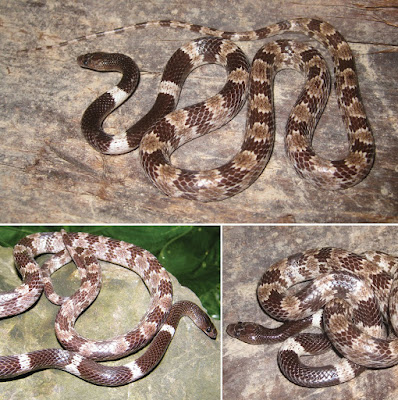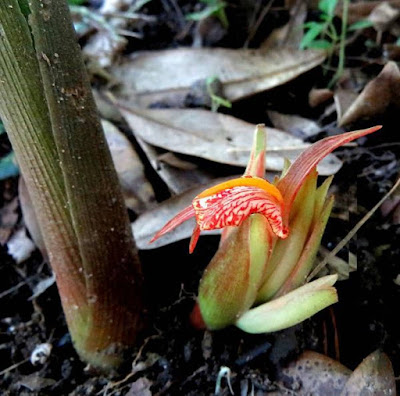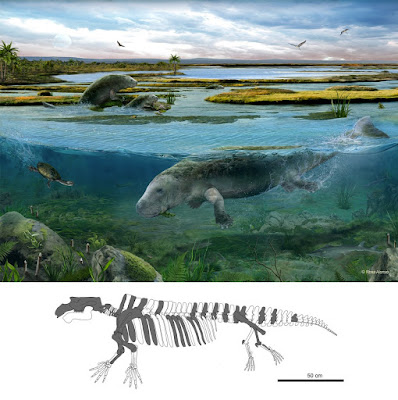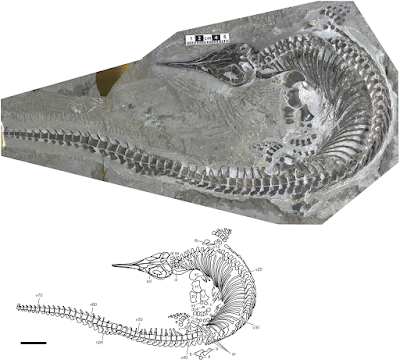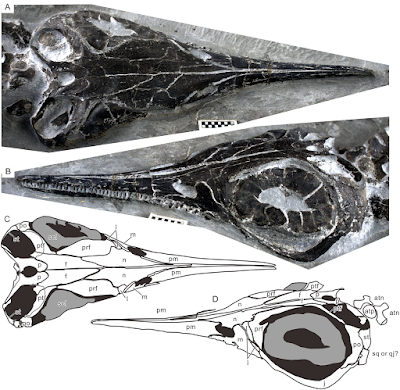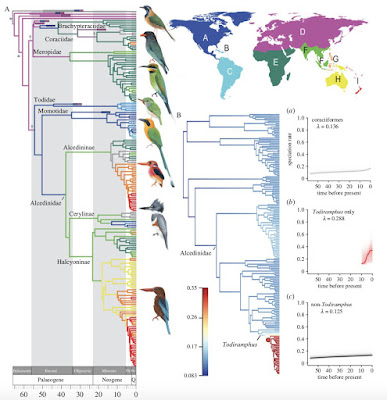[Most Recent Entries] [Calendar View]
Thursday, September 12th, 2019
| Time | Event | ||||||||||
| 3:00a | [Herpetology • 2019] Lycodon pictus • A New Species of Lycodon Boie, 1826 (Serpentes, Colubridae) from northern Vietnam
Abstract A new species of the genus Lycodon is described from Cao Bang Province, Vietnam, based on three individuals with distinct differences in morphology and molecular data. The new species is differentiated from its congeners by a combination of the following characters: dorsal scales in 17-17-15 rows, smooth throughout; supralabials usually eight (rarely nine); infralabials ten; one elongated loreal on each side, in contact with the eye; precloacal plate single; ventral scales 212–218 (plus one or two preventral scales); subcaudals 90 or 91; maxillary teeth 13 or 14; dorsal surface of body with 28 or 29 light body bands; dorsal surface of tail with 13 cream bands, forming a distinct blotch in the vertebral region. Based on phylogenetic analyses of mitochondrial cytochrome b sequence data, the new species is recovered as the sister species to a clade containing L. multizonatus and L. liuchengchaoi with strong support from the Bayesian analysis. The new species is at least 7.5% divergent from other species within this clade in uncorrected pairwise distance calculated using a fragment of more than 1000 bp of the mitochondrial cytochrome b. This discovery increases the number of Lycodon species known from Vietnam to 16. Keywords: Cao Bang Province, Lycodon pictus sp. nov., morphology, phylogeny, taxonomy
Lycodon pictus sp. nov. Diagnosis: Lycodon pictus sp. nov. can be differentiated from its congeners by the following morphological characters: dorsal scales in 17–17–15 rows, all smooth; supralabials usually eight (rarely nine); infralabials ten; one elongated loreal on each side, in contact with the eye; precloacal plate single; ventral scales 212–218 (plus one or two preventral scales); subcaudals 90 or 91; a total length of 597+ mm in males and 543 mm in females; tail / total length ratio 0.211–0.215; maxillary teeth 13 or 14; dorsal surface of body with 28 or 29 light body bands; dorsal surface of tail with 13 cream bands forming a distinct blotch in the vertebral region; ventral surface of body and tail mostly cream with the dark body bands in part extending towards the venter, sometimes forming complete dark bands around the body. ...
Distribution: Lycodon pictus sp. nov. is currently known only from Ha Lang and Trung Khanh districts, Cao Bang Province, northern Vietnam (Fig. 7). Etymology: The name of the species pictus means painted or decorated in Latin and refers to its unique dorsal colour pattern. Natural history: Lycodon pictus sp. nov. seems to be closely associated with karst environment. Specimens were found at night between 19:00 and 23:00, on forest paths or on the ground near cave entrances. The surrounding habitat was secondary karst forest, consisting of medium and small hardwood trees mixed with shrubs and vines. Air temperature was 23.4–29.6°C and humidity was 66–79%. Other reptiles were also found at the site, including Acanthosaura lepidogaster (Cuvier, 1829), Gekko adleri Nguyen, Wang, Yang, Lehmann, Le, Ziegler & Bonkowski, 2013, Goniurosaurus luii Grismer, Viets & Boyle, 1999, Lycodon futsingensis (Pope, 1928), and Protobothrops trungkhanhensis Orlov, Ryabov & Nguyen, 2009 (Fig. 8). Helen Y. Janssen, Cuong T. Pham, Hanh Thi Ngo, Minh Duc Le, Truong Q. Nguyen, Thomas Ziegler. 2019. A New Species of Lycodon Boie, 1826 (Serpentes, Colubridae) from northern Vietnam. ZooKeys. 875: 1-29. DOI: 10.3897/zookeys.875.35933 | ||||||||||
| 3:35a | [Botany • 2019] Zingiber perenense • A New Species in Zingiber section Cryptanthium (Zingiberaceae) from Nagaland, India
ABSTRACT Zingiber perenense N. Odyuo, D.K. Roy, C. Lyngwa & A.A. Mao, a new species belonging to Zingiber section Cryptanthium Horan. under family Zingiberaceae from Nagaland, Northeastern India is described and illustrated. Its affinities with the allied species are discussed. KEY WORDS: new species, Zingiber, Cryptanthium, Zingiberaceae, Nagaland, India. Zingiber perenense N. Odyuo, D.K. Roy, C. Lyngwa & A.A. Mao, sp. nov. Diagnosis: The new species differs from its allied congeners, Z. kangleipakensein pubescent, bilobed ligule, oblonglanceolate bracteole longer than corolla tube with 2-dentate apex, pubescent corolla tube with red lobes, white with purplish red streaked labellum, stalked anther with 3–4 mm long filament and in comparatively shorter style, 4.5–5 cm long and from Z. roseum in ovate to oblanceolate leaf blade pubescent on both sides, comparatively shorter, 1.5–3 cm long peduncle, oblong-lanceolate to oblong-linear pale green to creamy white bracts, corolla tube shorter than bracts, white with purplish red streaked labellum, with reduced, ovate, 2-dentate lateral staminodes and in pollen grains with striae non-confluent at apices. Distribution. INDIA: Nagaland (Peren district, Tesen village forest). So far only known from the type locality. Etymology. The specific epithet refers to the place of occurrence of this species. Nripemo Odyuo, Dilip Kr. Roy, Chalbasson Lyngwa and Ashiho A. Mao. 2019. Zingiber perenense, A New Species in Zingiber section Cryptanthium (Zingiberaceae) from Nagaland, India. The Thailand Natural History Museum Journal. 13(1); 1-10. Two new species of ginger discovered from Nagaland thehindu.com/sci-tech/energy-and-environ | ||||||||||
| 5:22a | [PaleoMammalogy • 2019] The Hind Limbs of Sobrarbesiren cardieli (Eocene, Northeastern Spain) and New Insights into the Locomotion Capabilities of the Quadrupedal Sirenians Abstract In the transition from a terrestrial to an aquatic environment, sirenian marine mammals reduced and lost their hind limbs and developed a horizontal caudal fin, the main propulsive organ in extant sirenians. Quadrupedal forms are only known from the Eocene and are represented by three different clades: the amphibious “prorastomids,” the aquatic quadrupedal protosirenids, and Sobrarbesiren cardieli, a four-legged sirenian from the middle Eocene of Spain, considered the sister taxon of the fully aquatic Dugongidae. This ecological shift from terrestrial to an aquatic environment was naturally associated with adaptations, among others, of the skeleton. However, sirenian hind limb bones have been poorly studied because of the scarce material available in the fossil record. Here, we describe in detail the hind limb bones of Sobrarbesiren, analyzing their functional morphology and comparing them with other basal sirenians and cetaceans, and with related terrestrial mammals such as proboscideans and hyracoids. The hind limbs of Sobrarbesiren were capable of a great variety of movements. Based on the presence of a strong sacroiliac articulation, we propose that it swam by dorsoventral pelvic undulation combined with pelvic paddling analogous to extant otters and the “prorastomid” Pezosiren. We also conduct the first microanatomical analysis of hind limb bones of an Eocene sirenian. Data reveal extreme inner compactness in the Sobrarbesiren innominate and femur, with the first description of osteosclerosis in an amniote innominate combined with the highest degree of osteosclerosis observed in amniote femora. The results confirm that the microanatomical changes precede the external morphological changes in such ecological transitions. The process of adaptation of sirenians to an aquatic life was thus a more complex process than previously thought. Keywords: Marine mammals, Aquatic adaptation, Bone microanatomy, Functional morphology Ester Díaz-Berenguer, Alexandra Houssaye, Ainara Badiola and José Ignacio Canudo. 2019. The Hind Limbs of Sobrarbesiren cardieli (Eocene, Northeastern Spain) and New Insights into the Locomotion Capabilities of the Quadrupedal Sirenians. Journal of Mammalian Evolution. DOI: 10.1007/s10914-019-09482-9 Ester Díaz-Berenguer, Ainara Badiola, Miguel Moreno-Azanza and José Ignacio Canudo. 2018. First Adequately-known Quadrupedal Sirenian from Eurasia (Eocene, Bay of Biscay, Huesca, northeastern Spain). Scientific Reports. 8: 5127. DOI: 10.1038/s41598-018-23355-w | ||||||||||
| 5:32a | [Paleontology • 2019] Chaohusaurus brevifemoralis • The New Ichthyosauriform (Reptilia, Ichthyosauromorpha) from Majiashan, Chaohu, Anhui Province, China
Abstract A new species of ichthyosauriform is recognized based on 20 specimens, including nearly complete skeletons, and named Chaohusaurus brevifemoralis. A part of the specimens was previously identified as Chaohusaurus chaoxianensis and is herein reassigned to the new species. The new species differs from existing species of Chaohusaurus in a suite of features, such as the bifurcation of the caudal peak neural spine and a short femur relative to trunk length. The specimens include both complete and partially disarticulated skulls, allowing rigorous scrutiny of cranial sutures. For example, the squamosal does not participate in the margin of the upper temporal fenestra despite previous interpretations. Also, the frontal unequivocally forms a part of the anterior margin of the upper temporal fenestra, forming the most medial part of the anterior terrace. The skull of the holotype largely retains three-dimensionality with the scleral rings approximately in situ, revealing that the eyeball was uncovered in two different directions, that is, laterally and slightly dorsally through the main part of the orbit, and dorsally through the medial extension of the orbit into the skull roof. This skull construction is likely a basal feature of Ichthyosauromorpha. Phylogenetic analyses place the new species as a sister taxon of Chaohusaurus chaoxianensis. Chaohusaurus brevifemoralis sp. nov. Chensaurus chaoxianensis Motani and You 1998a, in part, Motani et al. 2015c, in part, Zhou et al. 2017, in part Chaohusaurus geishanensis Motani and You 1998b, in part Diagnosis. Humeral anterior flange poorly developed, with weakly concave preaxial margin near midshaft; radial antero-proximal flange poorly developed; ulnar distal fan asymmetrical relative to bone axis, due to anterior expansion of distal preaxial margin; femur short for trunk length in comparison to Chaohusaurus chaoxianensis; tibia proximally narrow for trunk length in comparison to Chaohusaurus chaoxianensis; bifurcated neural spine near caudal peak; three tarsal ossifications in most individuals except newborns (Figs. 3 and 7). Locality. Majiashan, Chaohu, Anhui Province, China. Horizons. Ammonoid Subcolumbites zone, Spathian, Lower Triassic. Known specimens are from beds 621 to 638 (about 248.53–248.34 Ma) that were previously dated using astrochronology (Fu et al., 2016). Etymology. The specific name refers to the shortness of the femur relative to the body in comparison to other species. Conclusions: The new ichthyosauriform Chaohusaurus brevifemoralis is distinguished from existing species based on a suite of features, including the bifurcation of the neural spines near the caudal peak and short femora relative to the body. These differences are unlikely to be sexual dimorphisms, which are present in the species as an independent suite of characters (Motani et al., 2018). Chaohusaurus brevifemoralis is larger than its sister taxon, Chaohusaurus chaoxianensis, in body size. The two species were sympatric but likely pursued different resources from each other’s. Jian-Dong Huang, Ryosuke Motani, Da-Yong Jiang, Andrea Tintori, Olivier Rieppel, Min Zhou, Xin-Xin Ren and Rong Zhang. 2019. The New Ichthyosauriform Chaohusaurus brevifemoralis (Reptilia, Ichthyosauromorpha) from Majiashan, Chaohu, Anhui Province, China. PeerJ. 7:e7561. DOI: 10.7717/peerj.7561 | ||||||||||
| 10:11a | [Ornithology • 2019] A Laurasian Origin for A Pantropical Bird Radiation is Supported by Genomic and Fossil Data (Aves: Coraciiformes)
Abstract The evolution of pantropically distributed clades has puzzled palaeo- and neontologists for decades regarding the different hypotheses about where they originated. In this study, we explored how a pantropical distribution arose in a diverse clade with a rich fossil history: the avian order Coraciiformes. This group has played a central role in the debate of the biogeographical history of Neoaves. However, the order lacked a coherent species tree to inform study of its evolutionary dynamics. Here, we present the first complete species tree of Coraciiformes, produced with 4858 ultraconserved elements, which supports two clades: (1) Old World-restricted bee-eaters, rollers and ground-rollers; and (2) New World todies and motmots, and cosmopolitan kingfishers. Our results indicated two pulses of diversification: (1) major lineages of Coraciiformes arose in Laurasia approximately 57 Ma, followed by independent dispersals into equatorial regions, possibly due to tracking tropical habitat into the lower latitudes—the Coracii (Coraciidae + Brachypteraciidae) into the Afrotropics, bee-eaters throughout the Old World tropics, and kingfishers into the Australasian tropics; and (2) diversification of genera in the tropics during the Miocene and Pliocene. Our study supports the important role of Laurasia as the geographical origin of a major pantropical lineage and provides a new framework for comparative analyses in this charismatic bird radiation. Keywords: target capture, Coraciiavian systematics, North American gateway hypothesis, macroevolutionary dynamics, historical biogeography Jenna M. McCullough, Robert G. Moyle, Brian T. Smith and Michael J. Andersen. 2019. A Laurasian Origin for A Pantropical Bird Radiation is Supported by Genomic and Fossil Data (Aves: Coraciiformes). Proc. R. Soc. B. 286: 20190122. DOI: 10.1098/rspb.2019.0122 |
| << Previous Day |
2019/09/12 [Calendar] |
Next Day >> |
